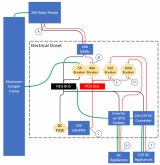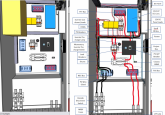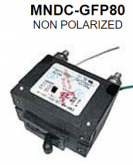Because it seems like you have devoted more time than most to thinking through and designing safety into your system, I'm wondering if you have any thoughts on
ground fault protection. Its something I've been intending to devote some time to learning about, but so far haven't found the time.
Apparently since 2008, NEC code has required PV arrays to incorporate a ground fault protection device (GFPD) such as
this one from midnite solar, but I haven't heard much talk about it, and I haven't come across anyone here building GFP into their systems (other than GFCI outlets on the AC side).
Do you have any thoughts on this class of safety device? Did you consider adding GFP to your system at any point in your planning?
OK, that
GFP breaker is on its way from N. Arizona Wind and Solar, along with all the other breakers in my updated design (see below). Thank you
@Dzl for pointing me to that product.
Because I had a hard time sourcing the Schneider breakers, and they didn't have a similar GFP breaker solution anyway,
I moved to all MidNite CBs in my updated design (below). So now, panels and arrestors are grounded to camper chassis but I'm keeping Inverter chassis & DC distribution grounds on the NEG bus.
So, you might ask, why not ground everything to Camper chassis? Well, I would if I put a similar GFP breaker on my load side but MS doesn't make one rated for those amps (would need to be 150-200A). I'll keep my eyes out for one, but I think I'm good for now. In the meantime, keeping those load grounds on NEG bus will trip my 100A or 50A breakers if either short to anything but the camper chassis. If they DO short to camper chassis, I expect that GFP will trip, but that isn't going to open my load CBs, so no protection offered by doing that.
Also, FYI, the MS GFP will only work if NEG bus is isolated from chassis ground, so if that 1/2A breaker sees any potential, it'll open the 80A breaker.
Additionally, I've
added an Inverter Precharge solution to keep my battery Disconnect Switch and Inverter Breaker from arcing when inverter caps reload when either of those get closed and those caps need to recharge. While doing that may be fine on occasion (&
@Will Prowse does it all the time

), do it enough times and those switches will fail & you may not know it if/when they do (or you will know it but only because one or the other don't work anymore i.e. bad things happen). Solution recommended to me by someone on ED forum is
a small 36V/25W lamp wired in parallel with the Inverter breaker and accompanying small dedicated switch and fuse -- you want to be able to turn it OFF after the caps are charged but before your inverter is turned back ON to keep inverter from sensing a LV condition caused by the lamp.
Also, instead of Inverter and DC2DC sharing the same EXTIO3 LVC cutoff switch, I'm
tapping into the back of SBMS0 to use EXTIO5 so each has a dedicated EXTIO cutoff (one on #3 and one on #5).
I'll update my
battery story on separate post, but short of the long of it is: BLS informs me they're in LA now so looking to receive those in the next few days, at which point I'll have everything to begin building out this new design except for some of the 12V distribution bits, induction cook top and LTE router/antenna. Ideally, I could begin balancing/cap testing this weekend and probably complete the camper build by end of June (assuming all the solar stars align ... I know, redundant!).
Changes applied (yellow-highlighted below). Click the pic
in this link for a higher rez version of this update (w/o the change highlights).








